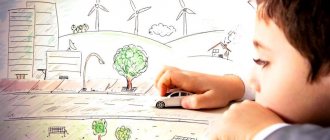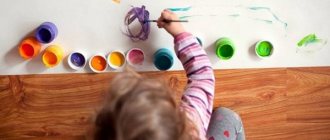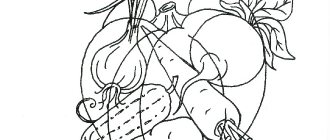Click on the picture. Wait while the visual editor loads. Show your imagination and ingenuity, complete the picture, and then save it. Everything is very simple. Surely you remember a situation when nothing comes to mind. You want to draw some picture, but you can’t. You need a push. Perhaps not only you need a push, but also children who draw standard sets of drawings - trees, houses.
An excellent exercise for relaxation and creative development. Completely different brain centers work. The development of fine motor skills of the hands, the development of the ability to concentrate on a task, imagination - all this is solved with the help of creative completion of unfinished pictures. You can find similar exercises using the keyword Doodle.
Use your imagination and draw your masterpiece
Just click on the picture and a graphic editor will appear in front of you, in which your preschooler can draw his own picture.
Go to the site for developing imagination for children and adults - complete unfinished drawings - droodles
Remember that your child has a much larger imagination. It's worth just pushing him a little. How? Everything is very simple - you should not draw the finished drawing, but complete the drawing. For example, complete the drawings I suggested. OP, and the baby started creating. To make it easier to create, a set of possible interpretations has been selected for each drawing. By developing imagination and drawing, the child develops fine motor skills of the fingers, secondly, he develops imagination, and thirdly, he learns perseverance, because every task and idea should be completed.
Development of imagination in children
One of the main functions of the imagination is to protect the individual and compensate for his negative experiences. Creative imagination helps to overcome oppressive emotions that could arise in any conflict. We can talk about imagination as a mental process only under the condition or presence of full consciousness. Therefore, psychologists say that imagination in children begins at the age of three. What types of imagination are there? In the structure of imagination, affective and cognitive components are distinguished, which go through a number of stages in their development.
Affective imagination
It arises in situations when contradictions arise between the images that the child has formed in his head and the very reality that surrounds him. When a child cannot resolve these contradictions, his internal tension, anxiety and fear grow. Proof of this is the large number of fears in three-year-old children. It is worth noting that children resolve many contradictions on their own. And the affective imagination helps them with this. In this regard, we can safely say that the main function of effective imagination is protective, which helps the child overcome internal contradictions. Effective imagination also performs a regulatory function during the child’s assimilation of behavioral norms. The development of affective imagination is carried out through the child’s playback of experiences. They are mainly associated with experiences of fear. And if parents organize such games at home, they help eliminate fear.
For example, a three-year-old boy asks to act out the fairy tale “The Three Little Pigs,” where the most significant moments he acts out are the scenes of a wolf appearing and running away from it. A wolf appears three times and three times our baby runs away from him squealing and screaming, hiding either in another room or behind a chair. And, you will do the right thing if you help your child with this. If suddenly a child experiences a strong emotional experience or impression, it is important to play out similar situations with him at home so that the child can act out his experiences. There are other possibilities for this. If, for example, a child already draws or sculpts, he can do this in drawing or sculpting.
Cognitive imagination
Along with affective imagination, cognitive imagination also stands out, which not only helps the child overcome emerging contradictions, but also complete and clarify a holistic picture of the world. With the help of cognitive imagination, children master patterns and meanings, build holistic images of events and phenomena. The development of cognitive imagination is carried out by the child while playing with toys.
The role of speech in the development of imagination in preschool children
Developed speech is a favorable factor in the development of imagination. It is speech that allows the child to imagine an object that he has never seen as best as possible, to reflect on this image, that is, to think. Developed speech frees the child from the power of immediate impressions, allows him to go beyond their limits, and, therefore, build more adequate (consistent) images of the surrounding reality. Therefore, delays in speech development also provoke delays in the development of imagination.
Stages of imagination development in children
First stage
in the development of imagination in children, it appears by the age of 2.5 years. Already at this age, imagination is divided into affective and cognitive. The duality of imagination is associated with two psychological characteristics of early childhood.
- With the highlighting of the personal “I”, in connection with this, the child’s experience of his separation from the world around him
- With the emergence of visually effective thinking.
The first of these features represents the basis for the development of affective imagination, and the second - cognitive. The weaker the child’s “I”, his consciousness, the less adequately he perceives the surrounding reality, the more acutely this contradiction is felt between the child’s imaginary world and the surrounding reality. If you look from the other side, the less developed a child’s objective thinking is, the more difficult it is for him to perceive and complete the real picture of the world around him.
Second phase
The development of imagination in children begins at 4-5 years old. There is an active assimilation of norms, rules and patterns of behavior, which naturally strengthens the child’s “I” and makes his behavior more conscious in comparison with the previous period. At this age, the frequency of occurrence of persistent fears decreases (since with the development of consciousness, the effects of distorted perception of the surrounding reality decrease). Typically, the affective imagination of a healthy child arises in connection with the experience of real trauma. For example, a five-year-old child, after undergoing surgery, operated on his friend, a bunny, for a month. Stable internal conflicts manifest themselves in the construction of substitute situations: for example, a child comes up with a story about a bad boy who commits pranks instead of him and the like. Cognitive imagination at this age is closely related to the development of role-playing games and productive activities - drawing, modeling, designing.
Third stage
The development of imagination in children begins at 6-7 years old. At this age, the child masters basic patterns of behavior and gains freedom to operate with them. He can deviate from standards, combine them, using these standards in constructing products of the imagination.
What is imagination and why develop it
Imagination is a mental process, a person’s ability to imagine new images based on existing experience.
The process of imagination is inextricably linked with thinking and memory. By developing imagination, we activate the brain, so it is important to stimulate the child in this process, especially since children love to invent.
The child masters the world, the rules of behavior in society, interaction with other people through fantasy and play. Not a single thing in the world would be invented if there was no imagination.
Development of creative imagination in children
The imagination of a preschooler differs from the imagination of an adult; behind its apparent wealth lies poverty, vagueness, sketchiness and stereotyping of images. Features of imagination development in preschool age:
- imagination takes on an arbitrary character, presupposing the creation of a plan, its planning and implementation;
- it becomes a special activity, turning into fantasy;
- the child masters the techniques and means of creating images;
- imagination moves to the internal plane, there is no need for visual support for creating images.
A preschooler does not create anything fundamentally new from the point of view of social culture. The characterization of the novelty of images matters only for the child himself: whether this was the case in his own experience.
For children of this age, an illustration is important that clearly depicts those actions and relationships of the characters in which their internal characteristics and character traits are most clearly revealed.
At the age of 4-5, children’s creative expressions in activities increase, especially play, manual labor, storytelling and retelling. At the age of five, dreams about the future appear. They are situational, often unstable, caused by events that caused an emotional response in children.
The preschooler “breaks away” in his imagination from a specific situation, he has a feeling of freedom, independence from it. He seems to rise above the situation and sees it through the eyes of not only different people, but also animals and objects.
The growth of the arbitrariness of imagination is manifested in a preschooler in the development of the ability to create a plan and plan its achievement.
Imagination allows the baby to explore the world around him, performing a gnostic function. It fills gaps in his knowledge, serves to unite disparate impressions, creating a holistic picture of the world.
Danish storyteller Ib Spang Olsen wrote: “When it seems to us, adults, that a child is a great dreamer, then it is quite possible that the child is simply trying to find a reasonable explanation for something...”
Imagination arises in situations of uncertainty, when a preschooler finds it difficult to find an explanation in his experience for any fact of reality. This situation brings together imagination and thinking.
As L.S. Vygotsky rightly emphasized, “these two processes develop interconnectedly.”
Types of imagination
Imagination is of the following types:
- recreating - the most common type, when images in the head are recreated on the basis of some information, for example, when reading a book, we imagine characters, places, events;
- creative - images appear in the head in new formats without relying on existing information. This type of imagination must be purposefully developed, since it is not formed on its own;
- uncontrollable - the type is characteristic of “violent dreamers” and inventors who cannot control their flow of fantasies, have no consistency and logic of images and often do not distinguish between reality and fiction.
Tips for parents on how to develop their child's creative abilities
To help develop intellectual and creative abilities, you can use the following recommendations:
- Play construction sets with your son/daughter more often, but do not use instructions on how to assemble the parts correctly.
- After reading a fairy tale or story, invite your child to imagine himself in the place of the main character. Let him fantasize, talk about his experiences, come up with what kind of plot could unfold with his participation.
- When the baby tells you something, ask clarifying questions. Let the child describe in detail the place where the action took place, the clothes of the characters, their character, habits, desires, etc.
On a note! If possible, visit children's development centers where teachers will help develop creative thinking.
Parents need to promote the development of thinking and imagination, so that in the future the child grows up inquisitive, thinks creatively, and quickly makes the right decisions in difficult situations.
leave a comment
Activities that help develop creativity
At home, you can come up with many interesting games that will help develop children's thinking and imagination.
- Puppet show . You don't have to use real puppets to create a fun show. Gather any items in a large box: cups, plastic utensils, cocktail straws, etc. It is important that the objects are not sharp and cannot harm the child. Now let your child come up with his own story using the contents of the box.
- A picture from fragments . Together with your son or daughter, cut out photographs of people, animals, images of objects from unnecessary magazines and newspapers. Then spread out a large sheet of paper and ask them to make a collage on a specific topic.
- A story about natural materials . When you go for a walk with your baby, collect any items in a bag: pine cones, pebbles, sticks, twigs. At home, invite your son or daughter to take one item out of the bag and come up with a short story about it. Next, the child takes out the next item, and he needs to add it to the story.
- Big box . In construction departments or household chemical stores, you can ask for a large cardboard box. Place it in your child's room and let him figure out what it will be: a house, a spaceship, a submarine, etc. Using markers, pencils, felt-tip pens, and stickers, he can decorate the box at his discretion. The task of adults is to help cut out windows or any other openings.
- Drawing without a brush . The baby is used to painting with paints and a brush, but there are so many objects that can replace a brush: a foam sponge, a piece of raw potato, a circle of apple, even your own fingers. Lay out a sheet of paper, hand your child paints and supplies, and then watch the creativity fly.
conclusions
The modern world requires a person to be able to find non-standard solutions to problems. Already in elementary school, the child is faced with tasks that require a creative approach to successfully complete. Preschool age is considered the most favorable for the development of imagination. To do this, there are many games and exercises in which kids need to independently come up with something new and unusual. And don’t forget to set an example for your child, because children copy the behavior of adults: play and fantasize with your baby.





